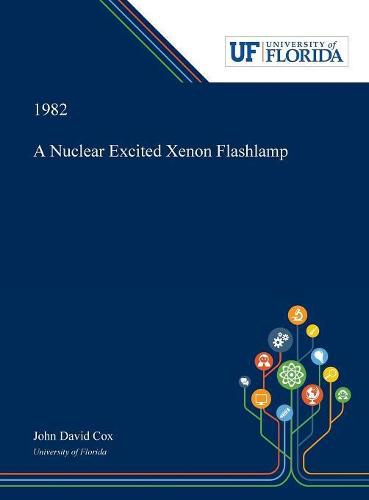Readings Newsletter
Become a Readings Member to make your shopping experience even easier.
Sign in or sign up for free!
You’re not far away from qualifying for FREE standard shipping within Australia
You’ve qualified for FREE standard shipping within Australia
The cart is loading…






Abstract: A Xenon flashlamp containing a mixture of Helium-3 and Xenon at 4 atm is irradiated by a pulse of thermal neutrons moderated from a burst reactor. Energy is produced via the He3(n, p)T3 reaction to ionize and excite the Xenon gas. The Xenon then radiates the absorbed energy as a grey body with a color temperature proportional to the power density created by the nuclear reactions. At very low power densities, the Xenon will form Xenon Dimers and radiate almost entirely in the Vacuum UV spectra ( 170 nm). As the power density increases, this Dimer radiation is self-absorbed heating the Xenon gas to high temperatures and a transition to black-body radiation occurs. At thermal neutron flux levels of 10e17/sqcm.s (250us pulse), a 4 atm loading (3:1 He: Xe), a power density of 1 kW/cubic cm is achieved. The light output of this Xenon flashlamp is comparable to an electric discharge lamp with a current density of about 1,500 amp/sqcm. The corresponding black-body emission spectra under these conditions has a peak wavelength at 480 nm. This flashlamp was developed as part of a larger effort to produce a nuclear-pumped laser. The burst reactor used in this study was at Aberdeen Proving Grounds in Maryland.
Dissertation Discovery Company and University of Florida are dedicated to making scholarly works more discoverable and accessible throughout the world. This dissertation, A Nuclear Excited Xenon Flashlamp by John David Cox, was obtained from University of Florida and is being sold with permission from the author. A digital copy of this work may also be found in the university’s institutional repository, IR@UF. The content of this dissertation has not been altered in any way. We have altered the formatting in order to facilitate the ease of printing and reading of the dissertation.
$9.00 standard shipping within Australia
FREE standard shipping within Australia for orders over $100.00
Express & International shipping calculated at checkout
Abstract: A Xenon flashlamp containing a mixture of Helium-3 and Xenon at 4 atm is irradiated by a pulse of thermal neutrons moderated from a burst reactor. Energy is produced via the He3(n, p)T3 reaction to ionize and excite the Xenon gas. The Xenon then radiates the absorbed energy as a grey body with a color temperature proportional to the power density created by the nuclear reactions. At very low power densities, the Xenon will form Xenon Dimers and radiate almost entirely in the Vacuum UV spectra ( 170 nm). As the power density increases, this Dimer radiation is self-absorbed heating the Xenon gas to high temperatures and a transition to black-body radiation occurs. At thermal neutron flux levels of 10e17/sqcm.s (250us pulse), a 4 atm loading (3:1 He: Xe), a power density of 1 kW/cubic cm is achieved. The light output of this Xenon flashlamp is comparable to an electric discharge lamp with a current density of about 1,500 amp/sqcm. The corresponding black-body emission spectra under these conditions has a peak wavelength at 480 nm. This flashlamp was developed as part of a larger effort to produce a nuclear-pumped laser. The burst reactor used in this study was at Aberdeen Proving Grounds in Maryland.
Dissertation Discovery Company and University of Florida are dedicated to making scholarly works more discoverable and accessible throughout the world. This dissertation, A Nuclear Excited Xenon Flashlamp by John David Cox, was obtained from University of Florida and is being sold with permission from the author. A digital copy of this work may also be found in the university’s institutional repository, IR@UF. The content of this dissertation has not been altered in any way. We have altered the formatting in order to facilitate the ease of printing and reading of the dissertation.